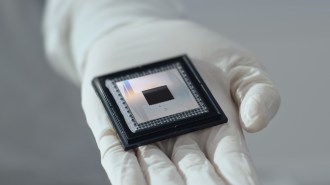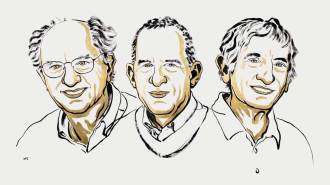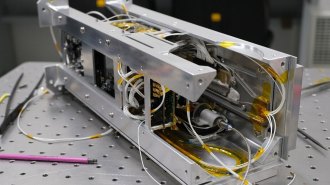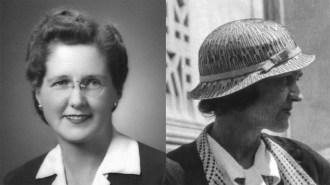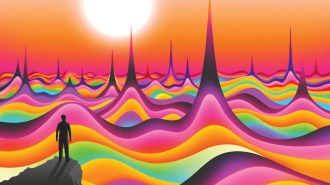Quantum histories get all tangled up
Tracing a particle’s past requires multiple chronologies, physicists say

TEMPORAL FORK When there’s a fork in the road, nature may take Yogi Berra’s advice and take it. A new experiment suggests that reality can split into multiple intertwined timelines, a phenomenon termed “entangled histories.”
tiero/istockphoto
Choose Your Own Adventure books are fun, but they let readers choose only one version of events at a time. Quantum mechanics, a new experiment suggests, requires that multiple adventures occur simultaneously to create a consistent account of history.
Nobel laureate Frank Wilczek at MIT and colleague Jordan Cotler, now at Stanford University, provide evidence for what they call entangled histories in a paper posted online January 12 at arXiv.org. The researchers proposed and collaborated on an experiment that started and ended by measuring a particular property of a photon; in between, the experimenters subtly probed the photon without disturbing its delicate quantum state. The head-scratching result was that there was no way to create a single chronology that could describe how the photon changed. Instead, there must be multiple chronologies that are entangled, sharing a quantum connection usually reserved for groups of particles rather than chunks of time.
“There really is something very deep going on here about the nature of quantum mechanics and time,” Cotler says. “Our best description of the past is not a fixed chronology but multiple chronologies that are intertwined with each other.” The experiment may offer a new means of exploring and interpreting quantum weirdness.
The quantum world is ruled by probabilities. Typically, physicists monitoring a photon can calculate the odds that it will have a particular characteristic, such as horizontal polarization, when it is measured. But if that photon has an entangled partner, then it becomes impossible to calculate the probabilities for one photon or the other. You can describe only the entire entangled system.
Rather than pondering multiple quantum objects, Cotler and Wilczek thought about individual particles at multiple moments in time. Building on 1984 work by Carnegie Mellon University physicist Robert Griffiths (SN Online: 2/5/14), Cotler and Wilczek thought about quantum versions of chronologies. If physicists could describe the polarization of a photon at time A and time B, then they should be able to make a coherent timeline charting the photon’s polarization changes in between.
Yet Cotler and Wilczek suspected that it wasn’t so simple. In a paper last year, they introduced the idea of entangled histories, cases in which a single chronology is insufficient to explain the observed changes in the properties of a particle. Just as the understanding of an entangled particle is impossible without considering its partner, the history of a particle could be incomplete without the existence of multiple entangled timelines.
A Chinese team recently put entangled histories to the test. The researchers injected photons one at a time into an interferometer. A photon only made it through the interferometer if it passed through three selective mirrors, each of which discarded light with a particular polarization. For each photon that reached a final detector, the researchers knew the photon’s initial and final polarizations as well as clues to the polarization of the photon when it passed through each mirror.
Just as Cotler and Wilczek expected, the experimenters couldn’t formulate a chronology that was consistent with both the starting and ending measurements of each photon and the mirror-based evidence in between. The only way to reconcile all the observations, Cotler says, is to conclude that the photon went through multiple histories in parallel. When the researchers made the final measurement of the photon, those alternate timelines merged.
Other physicists are not convinced that the new research goes beyond the ideas put forth by Griffiths and others over the past three decades. MIT quantum physicist Seth Lloyd calls the work “evolutionary but not revolutionary,” though he still wants to review the paper’s arguments more carefully.
Wilczek is far more optimistic. He calls the experiment “a rather direct realization” of a 60-year-old interpretation of quantum mechanics known as “many worlds,” in which measuring photons and other environmental interactions split reality into alternate timelines. Sometimes the different branches are consistent on their own and remain separate, Wilczek says. But in this case, the separate chronologies are intertwined and eventually come back together. “The deepest and most appealing aspect of this experiment,” he says, “is that it allows you in a mathematically precise way to nail what exactly many worlds is about.”
Editor’s Note: Frank Wilczek is on the board of trustees of Society for Science & the Public, which publishes Science News.

